
Helix Energy Solutions Group, Inc. provides world-class services to the offshore energy industry with a focus on subsea construction and well intervention operations in both the Gulf of Mexico as well abroad; offering vessels for hire that are specially equipped for each need!
The company operates through three segments: Well Intervention, Robotics, and Production Facilities. The Well Intervention segment offers vessels and related equipment that are used to perform well intervention services primarily in the Gulf of Mexico and North Sea regions. The Robotics segment involves four chartered vessels which complement offshore construction and well intervention services. The company specializes in providing decommissioning of offshore oil wells.
Decommissioning an offshore oil well generally includes three main stages: decommissioning the platform, decommissioning the subsea infrastructure, and decommissioning the pipelines. Decommissioning the platform typically involves removing the topside equipment and facilities, and then either leaving the platform in place or dismantling it. Decommissioning the subsea infrastructure generally involves removing the production wells, decommissioning the associated control systems, and plugging and abandonment of any unused wells. Decommissioning pipelines generally involves the removal of any remaining product from the pipeline, decommissioning of any associated control systems, and finally pipeline decommissioning itself. The time it takes to decommission an offshore oil well can vary depending on several factors, but typically it takes between two and five years to complete all three stages.
With the dramatic price increase in Crude Oil, the services that Helix provides have become extremely sought after. Decommissioning an offshore oil well is a complex and expensive process, but it is essential for protecting the environment and ensuring public safety.
The company reported revenue of $674 million in 2021 and reported negative earnings growth of -41 cents per share. Helix’ chief competitors include Subsea 7, TechnipFMC, Saipem, and Seadrill. The company has a market capitalization of $663 million and on average $HLX trades 2.7 million shares per day.
Their clients are some of the “world’s leading” oil companies including but not limited to: ExxonMobil, Chevron, Shell, Total & Anadarko. $HLX operates globally.
In this weekly stock study, we will look at and analyze the following indicators and metrics as are our guidelines which dictate our behavior in deciding whether to buy, sell, or stand aside on a particular stock.
- Wall Street Analysts’ Estimates
- 52-week high and low boundaries
- Best Case – Worst Case Analysis
- Vantagepoint A.I. Forecast (Predictive Blue Line)
- Neural Network Forecast
- Daily Range Forecast
- Intermarket Analysis
- Our trading suggestion
We don’t base our decisions on things like earnings or fundamental cash flow valuations. However, we do look at them to better understand the financial landscape that a company is operating under.
Analysts Ratings
The first set of boundaries which we explore in our stock study is what do the professionals think who monitor the stock for a living. We can acquire this information by simply looking at the boundaries that the top Wall Street Analysts set for $HLX. This initial set of boundaries provides us with an idea of what is expensive, fairly valued, and cheap.
Based on top Wall Street analysts offering 12-month price targets for Helix Energy Solutions in the last 3 months.
The average price target is $7.75 with a high forecast of $8.00 and a low forecast of $7.50. The average price target represents an 80.65% change from the last price of $4.29
Despite its recent rally, these Wall Street Analysts still feel that the stock is UNDERVALUED. Since $HLX is a small cap stock it is only covered by a handful of analysts. This also needs to be factored into our final trading analysis.
Analysts see that HLX is undervalued. In terms of Price-to-Sales ratio, which is considered as one of the best valuation metrics, the stock looks quite cheap now. HLX is currently trading at 0.90 times its sales. In other words, investors need to pay only 90 cents for each dollar of sales. As long as the bull market in Crude oil continues this will continue to entice longer term investors.
52-week High-Low Chart
Where the rubber meets the road as far as analysis is concerned is looking at the charts and evaluating where the asset stands in relation to its 52-week highs. As counterintuitive as it may sound, great stocks tend to consistently make new 52-week highs. While many on Wall Street prefer to buy low and sell high, strong trends require a trader to learn how and when to buy high and sell higher.
One of the simplest ways to evaluate a stock is to look at some long-term monthly and weekly charts to be able to zoom out and see the big picture of the trend. Some of the greatest traders in the world use longer-term monthly charts to determine trend analysis.
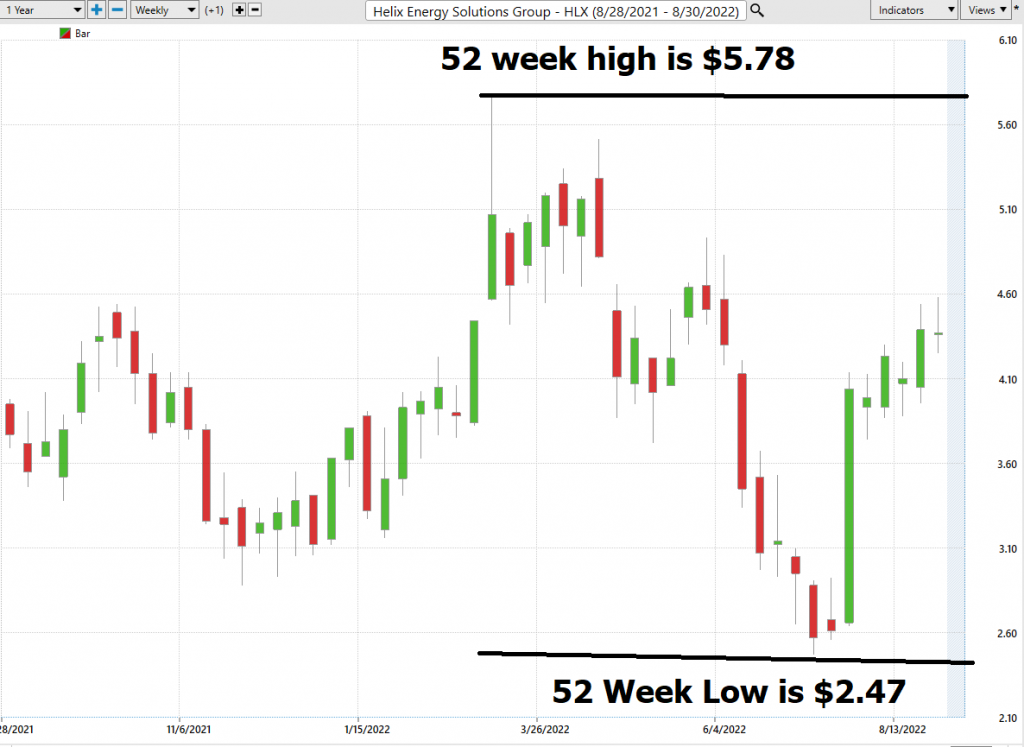
Over the last 52 weeks $HLX has traded as high as 5.78 and as low as $2.47. Its most recent close was $4.29.
Whenever we trade, we always pay attention to where we are in relation to the 52-week trading range. $HLX is currently trading at its 55th percentile on the annual 52-week chart.
The annualized volatility of $HLX is 77.2% which is extremely high. This is calculated by simply dividing the last close by the annual trading range. What this simple metric tells us is that based upon its current volatility it would be Statistically within the normal bounds for $HLX to trade 77.2% higher or lower over the coming 12 months.
Looking at Volatility in this regard provides us solid expectations of future price action. We contrast this perspective by always analyzing a 10-year chart to confirm these volatile expectations.
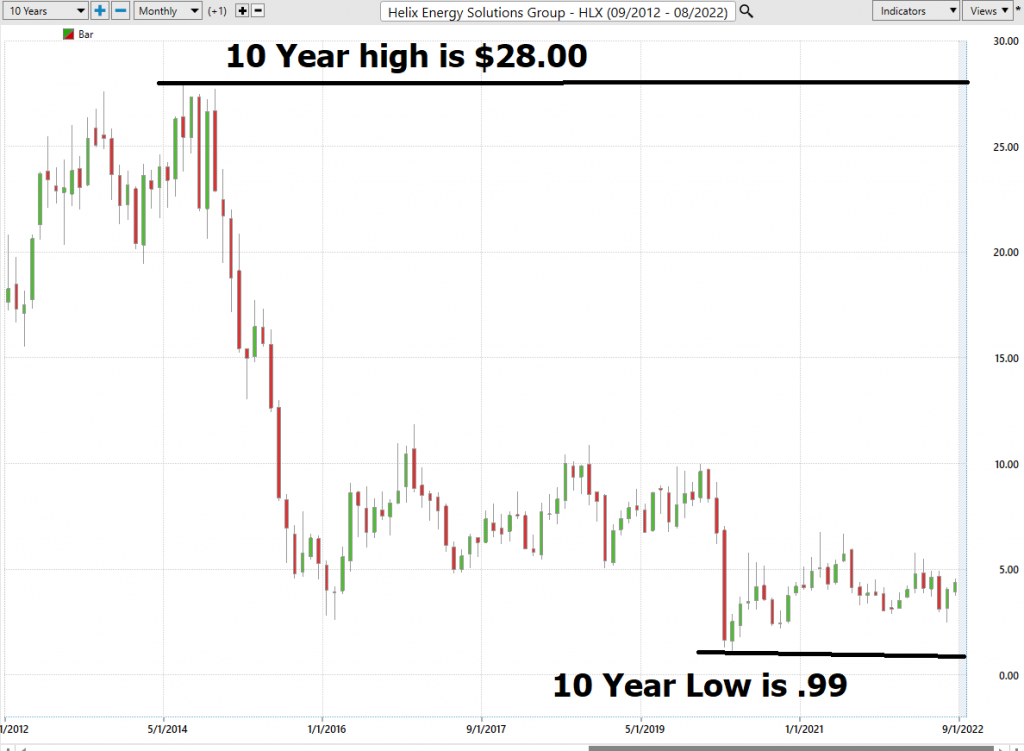
Best Case – Worst Case Analysis
We then like to realistically look at how the market rallied and declined over the past year to determine a perspective on most recent real volatility for $HLX. To do this we simply measure bottom to top rallies that had no lower lows, and peak to bottom declines that had no higher highs. This allows us to quickly see what the best case and worst case of market conditions looked like and provides a very realistic set of expectations moving forward.
Here is the worst-case analysis:
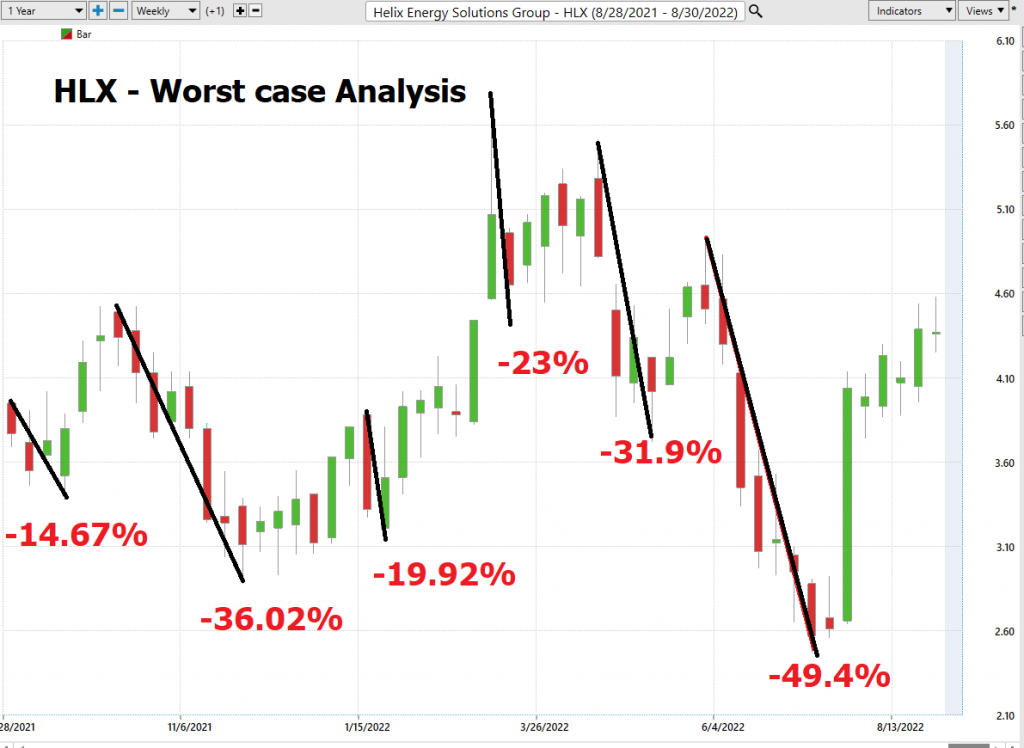
Followed by the best-case analysis:
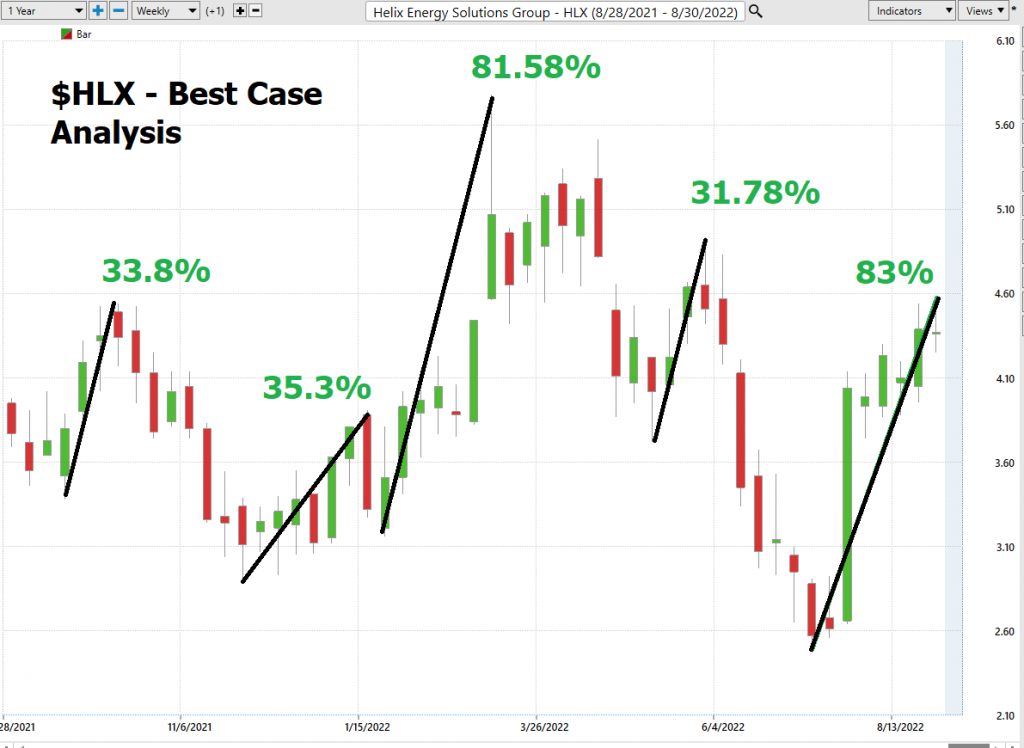
When you evaluate these rallies and declines the most straightforward conclusion you can make is that $HLX is an extremely volatile trading vehicle.
Next, we want to evaluate $HLX is in comparison to the performance of the major stock market indexes which we have greater familiarity with and then look at the drawdowns of the stock over the past year to get a worst-case scenario idea for any conclusions that we might reach when we trade this asset.
- Over the past year $HLX is UP 15.69%.
- The Dow Jones Industrials are down 10.1% over the past year.
- S&P 500 is down 11.8% over the last year.
- Russell 1000 Small Cap is down 13.48% in the past year.
- The NASDAQ is down 8.75%
You can see $HLX performed substantially better than the broader market indexes. But this performance has to be understood within the context that most of that performance came because of the rally in the past two months.
What were the worst-case drawdowns? The graphic below shows the bumpy ride.
We would expect this type of volatility to continue. This means that massive drawdowns peak to trough should be considered very normal moving forward.
Vantagepoint A.I. Forecast (Predictive Blue Line)
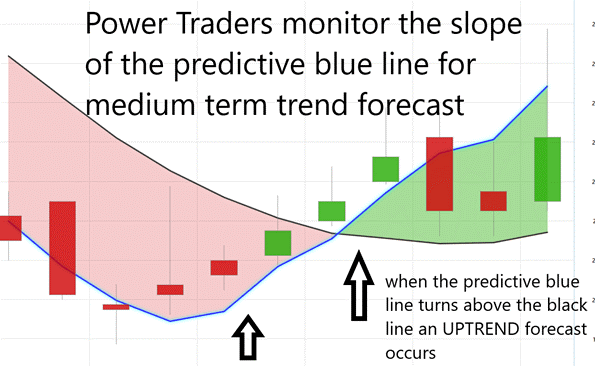
Using VantagePoint Software and the artificial intelligence, traders are alerted to trend forecasts by monitoring the slope of the predictive blue line. The black line is a simple 10 day moving average of price which simply tells you what has occurred in the market. The predictive blue line also acts as value zone where in uptrends traders try to purchase the asset at or below the blue line.
In studying the chart below, pay close attention to the relationship between the black line and predictive blue line. All that the black line tells you is what has occurred. It tells you where prices have been and what the average price over the last ten days is.
The predictive blue line, on the other hand utilizes that Vantagepoint patented Neural Network and Intermarket Analysis to arrive at its value. It looks at the strongest price drivers of an asset through artificial intelligence and statistical correlations to determine its value.
Whenever we see the predictive blue line move above the black line, we are presented with an UP-forecast entry opportunity. These are highlighted by UP arrows on the chart.
Whenever the predictive blue line moves below the black line, we are presented with a DOWN forecast. More importantly, there is no guesswork involved. Traders know where the value zone and trend are always.
Over the last 4 months there were 3 a.i. trend forecasts on $HLX.
#1 LONG for 3.6%
#2 Short for 33.96%
#3 Long for 38.09%
Total possible gains from utilizing the a.i. forecast were 75.65% over the last 4 months.
The clarity and effectiveness of these trend forecasts is how Power Traders embrace artificial intelligence to stay on the right side of the right trend at the right time.
Fine Tuning Entries with The Neural Net Indicator
At the bottom of the chart is the Neural Network Indicator which predicts future strength and/or weakness in the market. When the Neural Net Indicator is green it communicates strength. When the Neural Net is red it’s forecasting short term weakness in the market.
We advocate that Power Traders cross reference the chart with the predictive blue line and neural network indicator to create optimal entry and exit points.
A Neural Net is a computational learning system that uses a network of functions to understand and translate massive amounts of data into a desired output, consistently monitoring itself and improving its performance.
Power Traders are always looking to apply both the neural network and A.I. to the markets to find statistically sound trading opportunities. We refer to this as a “double confirmation” setup and look for the predictive blue line to slope higher and to be confirmed by the Neural Net at the bottom of the chart. In the world of technical analysis, trend confirmation refers to the verification of momentum in each market trend. This is typically done using statistical techniques. While trend confirmation does not guarantee success, it does provide traders with important quantitative probabilities that can help to improve their chances of making profitable trades. For this reason, trend confirmation is an essential tool for any technical trader. By double confirming trends, traders can minimize their risk and maximized their chances of success. By requiring two different indicators to line up, traders are effectively increasing the quantitative probabilities that their trade will be successful. While it is by no means foolproof, double confirmation will reduce risk and improve the chances of success for technical analysis traders.
The arrows on the following chart isolate all the occurrences when a double confirmation signal occurred.
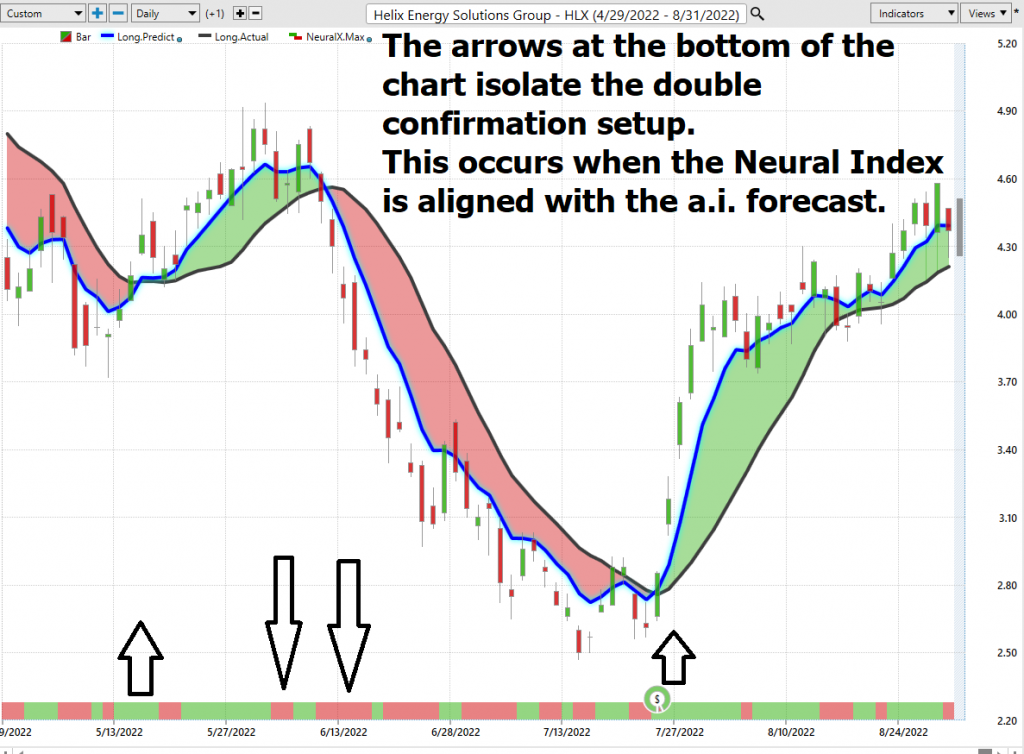
We advise Power Traders to cross reference the predictive blue line with the Neural Net for the best entry opportunities. Observe how the slope of the predictive blue line has remained positive from the time earnings were announced.
You can see in the chart above how the Neural Net offered several opportunities of double confirmation to Power Traders, when the predictive blue line and the Neural Net aligned with the same forecast. These instances provide extremely high probability trading opportunities to exploit the trend.
VantagePoint Software Daily Price Range Prediction
One of the powerful features in the Vantagepoint A.I. Software which Power Traders use daily is the Daily Price Range prediction forecast.
This forecast is what permits Power Traders to truly fine tune their entries and exits into the market.
Here are some important metrics to consider:
- The average daily trading range over the entire year has been 5.7% of the closing price.
- The average weekly trading range over the entire year has been 13.7% of the weekly closing price.
- The average monthly trading range over the entire year has been 30.7% of the monthly closing price.
Despite these huge volatile swings the Vantagepoint A.I. daily range forecast provides traders with exacting precision as to where to buy and sell.
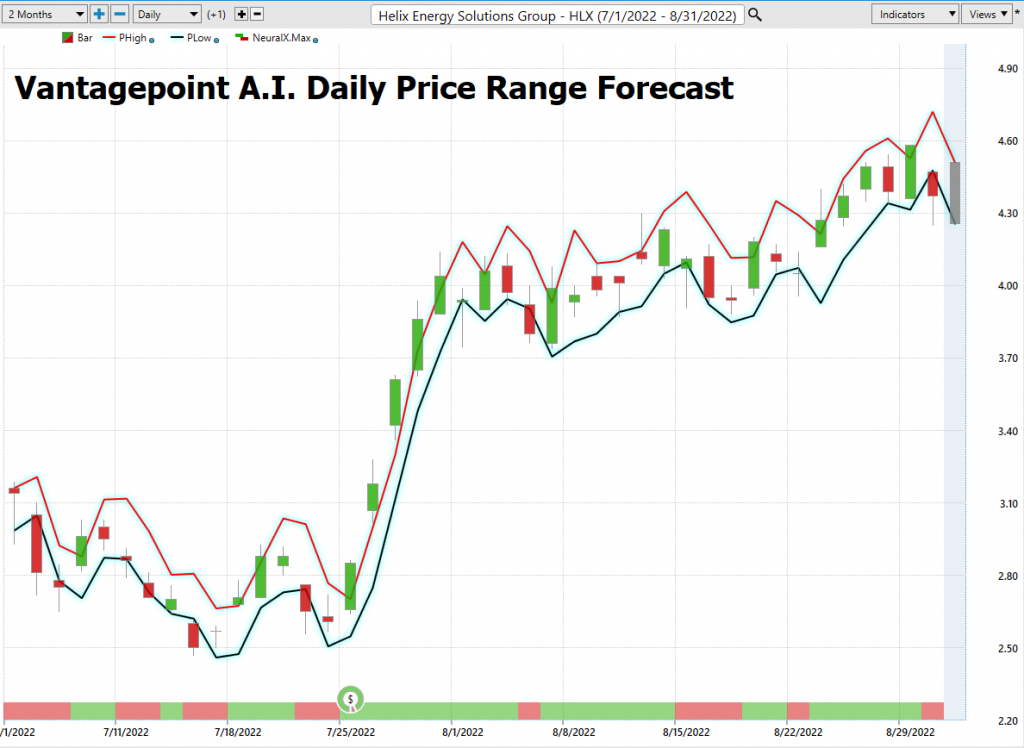
What is the most important feature that traders are concerned about? Traders need to know where to enter and exit a market. VantagePoint provides this answer with exacting precision. Every day the Daily Range forecast is updated to provide insight to anticipated price action.
Intermarket Analysis
What makes the Vantagepoint Software extraordinary is its capacity to perform Intermarket analysis and to find those assets which are most statistically interconnected and are the key drivers of price.
Studying the charts can always provide objective realities in terms of locating support and resistance levels which become noticeably clear on a chart. But we live in a global marketplace. Everything is interconnected. The billion-dollar question for traders is always what are the key drivers of price for the underlying asset that I am trading?
These intangibles are invisible to the naked eye yet show extremely high statistical correlations.
Small changes in Interest rates, Crude Oil Prices, and the Volatility of the dollar amongst thousands of other variables affect the decisions companies must make to survive in these challenging times. Trying to determine what these factors are is one of the huge problems facing investors and traders.
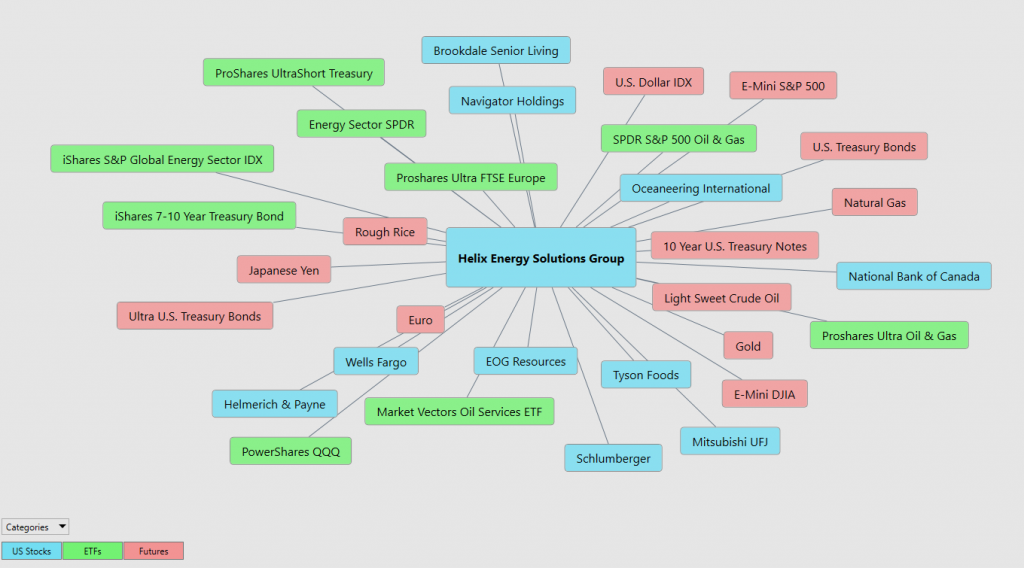
Correlation analysis can help traders identify relationships between different markets or assets that have historically moved together. By considering these connections, it’s possible to estimate trend probabilities with greater accuracy and determine potential opportunities for profit when the data shows a high degree of correlation among various investment options- which may also lead you down risky paths!
Trader risk is often magnified in markets with low liquidity. The Correlation Analysis can help traders identify which assets are more likely to move based off their past history, giving them an edge, and managing risks more effectively while reducing uncertainty for investors who want predictability about where the market might go next. By understanding how different assets have moved in relation to one another, traders can make predictions about which assets are more likely to move in a certain direction in the future. This type of analysis can give traders an edge in the market by helping them to identify potential opportunities and manage risk more effectively.
There is excellent value to be had in studying and understanding the key drivers of $HLX’s price action.
By doing so you can often see which ETFs are most likely acquiring $HLX as well as uncovering other industries which affect $HLX price movement.
This can be invaluable information because it allows a trader to locate other opportunities and see a listing of the ETF’s that are also buyers of $HLX. This knowledge is how other trading opportunities are often uncovered in their embryonic stages.
Suggestion for Traders
$HLX is an extremely fast paced stocks that is almost 300% more volatile than the broader market. Since it is a small cap stock it also means there is much less liquidity than trading large caps. Nonetheless, you can see that by incorporating all aspects of this trading analysis $HLX deserves to be on your trading radar.
However, this asset is not for the inexperienced or faint of heart. With an average monthly trading range of 30.7% an asset like $HLX will require you to practice exceptional money management. There is great risk and opportunity in trading $HLX.
The predictive blue line is the guidance that we will be following. Wall Street Analysts are slowly revising their estimates upward and we expect more analysts to start covering the stock based upon the ongoing bull market in Crude Oil.
The chart is volatile, but the momentum is beyond impressive. Use sharp pullbacks of 20%+ to begin extremely small allocations. Be nimble. This is very tradeable by seasoned traders who have experience utilizing the Vantagepoint A.I. daily range forecast. It requires an iron constitution and exceptional money management skills.
We will re-evaluate this analysis based upon:
- Wall Street Analysts’ Estimates
- 52-week high and low boundaries
- Vantagepoint A.I. Forecast (Predictive Blue Line)
- Neural Network Forecast
- Daily Range Forecast
- Intermarket Analysis
Let’s Be Careful Out There!
Remember, It’s Not Magic.
It’s Machine Learning.
IMPORTANT NOTICE!
THERE IS SUBSTANTIAL RISK OF LOSS ASSOCIATED WITH TRADING. ONLY RISK CAPITAL SHOULD BE USED TO TRADE. TRADING STOCKS, FUTURES, OPTIONS, FOREX, AND ETFs IS NOT SUITABLE FOR EVERYONE.
DISCLAIMER: STOCKS, FUTURES, OPTIONS, ETFs AND CURRENCY TRADING ALL HAVE LARGE POTENTIAL REWARDS, BUT THEY ALSO HAVE LARGE POTENTIAL RISK. YOU MUST BE AWARE OF THE RISKS AND BE WILLING TO ACCEPT THEM IN ORDER TO INVEST IN THESE MARKETS. DON’T TRADE WITH MONEY YOU CAN’T AFFORD TO LOSE. THIS ARTICLE AND WEBSITE IS NEITHER A SOLICITATION NOR AN OFFER TO BUY/SELL FUTURES, OPTIONS, STOCKS, OR CURRENCIES. NO REPRESENTATION IS BEING MADE THAT ANY ACCOUNT WILL OR IS LIKELY TO ACHIEVE PROFITS OR LOSSES SIMILAR TO THOSE DISCUSSED ON THIS ARTICLE OR WEBSITE. THE PAST PERFORMANCE OF ANY TRADING SYSTEM OR METHODOLOGY IS NOT NECESSARILY INDICATIVE OF FUTURE RESULTS. CFTC RULE 4.41 – HYPOTHETICAL OR SIMULATED PERFORMANCE RESULTS HAVE CERTAIN LIMITATIONS. UNLIKE AN ACTUAL PERFORMANCE RECORD, SIMULATED RESULTS DO NOT REPRESENT ACTUAL TRADING. ALSO, SINCE THE TRADES HAVE NOT BEEN EXECUTED, THE RESULTS MAY HAVE UNDER-OR-OVER COMPENSATED FOR THE IMPACT, IF ANY, OF CERTAIN MARKET FACTORS, SUCH AS LACK OF LIQUIDITY. SIMULATED TRADING PROGRAMS IN GENERAL ARE ALSO SUBJECT TO THE FACT THAT THEY ARE DESIGNED WITH THE BENEFIT OF HINDSIGHT. NO REPRESENTATION IS BEING MADE THAT ANY ACCOUNT WILL OR IS LIKELY TO ACHIEVE PROFIT OR LOSSES SIMILAR TO THOSE SHOWN.




